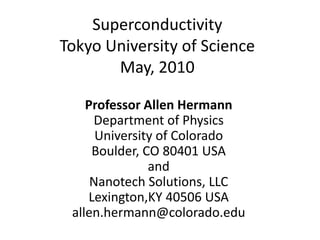
Lecture 1 introduction
- 1. Superconductivity Tokyo University of Science May, 2010 Professor Allen Hermann Department of Physics University of Colorado Boulder, CO 80401 USA and Nanotech Solutions, LLC Lexington,KY 40506 USA allen.hermann@colorado.edu
- 2. Syllabus for “Superconductivity”, a 7 (1 1/2 hour) lecture series in Low- Temperature Physics I at Tokyo University of Science, 2010 Allen Hermann, Ph.D. Lecture 1. Introduction Discovery, history, and superconducting properties (zero resistance and flux expulsion) Type I and Type II superconductors Low Tc and High Tc Materials
- 3. Lecture 2.Phenomenology: Superfluids and their properties Electrodynamics and the Magnetic Penetration Length The London Equations and magnetic effects Fluxoids
- 4. Lecture 3. Phenomenology: Ginsburg-Landau theory and the intermediate state •Landau Theory of Phase Transitions •Ginsburg-Landau Expansion •Coherence Length •The Ginsburg-Landau Equations •Abrikosov Lattice and Flux Pinning
- 5. Lecture 4. Microscopic Theory The 2-electron Problem Annihilation and Creation Operators Solution of the Schroedinger Equation Cooper Pairs The Many Electron Problem- BCS Theory Solution of the Many Particle Schroedinger Equation by the Bogoliubov- Valatin Transformation The BCS Energy Gap
- 6. Lecture 5. Josephson Effects Pair Tunneling and Weak Links SIS Josephson Junctions Superconducting Quantum Interference Devices (SQUIDs)
- 7. Lecture 6. Superconducting Materials and their structures Low Tc Metals and Alloys Organic superconductors High Tc materials: cuprates, borides, and AsFe superconductors
- 8. Lecture 7. Applications and Devices Levitation Wire applications and Superconducting Magnets Flux Flow Issues in High Tc, High Jc Wire Electronic devices Using Josephson Junctions and SQUIDS Nanotechnology and Superconductivity
- 9. Lecture 1 Introduction • Discovery, history and superconducting properties (zero resistance, magnetic flux expulsion) • Type I and Type II superconductors • Low Tc and High Tc materials
- 25. TYPES OF SUPERCONDUCTORS There are two types of superconductors, Type I and Type II, according to their behaviour in a magnetic field Type I superconducting state normal state This transition is abrupt Type I superconductors are pure metals and alloys
- 26. Type II superconducting normal state is gradual
- 27. WHAT IS SUPERCONDUCTIVITY?? For some materials, the resistivity vanishes at some low temperature: they become superconducting. Superconductivity is the ability of certain materials to conduct electrical current with no resistance. Thus, superconductors can carry large amounts of current with little or no loss of energy. Type I superconductors: pure metals, have low critical field Type II superconductors: primarily of alloys or intermetallic compounds
- 52. High Temperature Superconductivity 1986: J.G. Bednorz & K.A. Müller Tc up to 133K Schilling & Ott ‘93 Doped antiferromagnetic Mott insulator Generic Phase Diagram Copper-oxide compounds T TN T* strange La2-xBaxCuO4 Tc =35 K metal spin gap AF Tc SC CuO2 plane under optimally over x doped Are they unconventional superconductors? Not ordinary metals!
- 55. Record TC versus Year Discovered 180 HgBa2Ca2Cu2O8 Pressure 160 HgBa2Ca2Cu2O8 140 Tl-Ba-Ca-Cu-O 120 Bi2Sr2Ca2Cu3O8 TC (K) 100 YBa2Cu3O7 80 60 La-Sr-Cu-O 40 NbN La-Ba-Cu-O 20 Nb3Ge Hg 0 1986 1900 1910 1920 1930 1940 1950 1960 1970 1980 1990 2000 Year
- 58. SOME HIGH Tc SUPERCONDUCTORS Chemical formula Tc Hg0.8Tl0.2Ba2Ca2Cu3O8.33 138 K (record-holder) HgBa2Ca2Cu3O8 133-135 K HgBa2CuO4+ 94-98 K Tl2Ba2Ca2Cu3O10 127 K TlBa2Ca2Cu3O9+ 123 K TlBa2Ca3Cu4O11 112 K Ca1-xSrxCuO2 110 K Highest-Tc 4-element compound YBa2Cu3O7+ 93 K La1.85Sr0.15CuO4 40 K La1.85Ba.15CuO4 35 K First HTS discovered - 1986 (Nd,Ce)2CuO4 35 K
- 62. APPLICATIONS: Superconducting Magnetic Levitation The track are walls with a continuous series of vertical coils of wire mounted inside. The wire in these coils is not a superconductor. As the train passes each coil, the motion of the superconducting magnet on the train induces a current in these coils, making them electromagnets. The electromagnets on the train and outside produce forces that levitate the train and keep it centered above the track. In addition, a wave of electric current sweeps down these outside coils and propels the train forward. The Yamanashi MLX01MagLev Train
- 65. A superconductor displaying the MEISSNER EFFECT Superconductors have electronic and magnetic properties. That is, they have a negative susceptibility, and acquire a polarization OPPOSITE to an applied magnetic field. This is the reason that superconducting materials and magnets repel one another. If the temperature increases the sample will lose its superconductivity and the magnet cannot float on the superconductor.